#migrant hawker
Explore tagged Tumblr posts
Text





29/10/24-Autumn colour including dogwood leaves, Red Admiral, Grey Squirrel and Greylag Goose on a bright lunch time walk at Lakeside Country Park today
Blackbird, Carrion Crow, Moorhen, Great Crested Grebe, Migrant Hawker, red clover, wet yarrow which looked nice, wild carrot seed heads and guelder rose berries were other highlights with Collared Dove, Woodpigeon, Feral Pigeon, Starling, House Sparrow, Great Tit, Goldfinch, Long-bodied Cellar spider and another spider good to see at home.
#photography#great tit#grey squirrel#greylag goose#moorhen#great crested grebe#carrion crow#starling#feral pigeon#birdwatching#outdoors#migrant hawker#tuesday#autumn#sunny#eastleigh#hampshire#england#uk#yarrow#flowers#wildlife#spiders#home#europe
13 notes
·
View notes
Text



Efterårs-mosaikguldsmed (Aeshna mixta)
Han.
Migrant Hawker (Aeshna mixta)
Male.
#Efterårs-mosaikguldsmed#Aeshna mixta#Aeshna#Migrant Hawker#Mosaikguldsmed#Hawker#Aeshnidae#Dragonfly#Guldsmed#Odonata#Insekt#Insect#Sommer#Summer#Kølsen-Skals Engsø
10 notes
·
View notes
Text
Cast skins: evidence of rebirth

View On WordPress
#Aeshna grandis#Aeshna mixta#Brown hawker#Dragonfly#eclosion#exuvia#exuviae#hemimetaboly#incomplete metamorphosis#Larvae#Migrant hawker#Odonata#teneral
2 notes
·
View notes
Text


two different types of dragonflies in the garden around my pond!
4 notes
·
View notes
Video
Migrant Hawker (Aeshna mixta) M by pete beard Via Flickr: #yovonespond #October
0 notes
Note

Hello, I found this beauty hanging around in a bush and she even let me close to photograph her! She is so gorgeous!
Found her in North-Rhine Westphalia, Germany. Could you help identifying her?
Dragonfly ID - Germany:
Hello, yes, I think this is a Migrant Hawker Dragonfly (Aeshna mixta), family Aeshnidae.
Migrant hawker - Wikipedia
Aeshna mixta (Migrant Hawker) – Odo-nutters (odonata.org.uk)
132 notes
·
View notes
Text

migrant hawker (aeshna mixta), male
11 notes
·
View notes
Text
Alfred, Alexia, and the Dragonfly
The infamous video of Alfred and Alexia torturing a dragonfly and feeding it to the ants can be found twice on Rockfort Island. The first time, you see it in the room with the Lugers and then again in Alfred’s office as the startup of his PC. Of course, it has a deeply person meaning to Alfred. We know about his obsession with his sister, and Alexia is in there as well. Maybe the video is the only one with her or the last one that was taken before her cryogenic sleep. It makes sense that Alfred would hold dear something like this. But is it just about Alexia, or is there more to it? After all, we even have to watch it twice.
The twins do not talk the entire time and barely interact during the video. The only noteworthy interaction happens during the last scene, in which Alfred and Alexia share a knowing gaze. The way they look at each other makes it clear that there is more to the whole scene than what meets the eye. It had a deeper meaning, which only they could understand. A secret they share with each other. Words are not necessary.

When I first played Code Veronica X, I assumed the video mainly existed to show the cruel and twisted nature of the twins, while it also foreshadowed what Alfred would become. But after replaying the game last year, I changed my opinion. The video isn’t about Alfred and Alexia’s general cruelty or torturing of defenseless creatures. The content represents something more personal to them - their revenge on Alexander.
It was never said when the video was recorded, but the twins aren’t small children anymore. Based only on their appearance, I would estimate them to be between 10 and 12 years old. Now, considering the content of the video, I think it was recorded after Alfred discovered the truth about their origin and after they came up with a revenge plan as the earliest possible date. However, it is more likely that they had already executed their plan some time before.
Let’s take a closer look. First of all, the visual language. The ants symbolize Alfred and Alexia. Alexia sees herself as an ant queen and refers to Alfred as a soldier ant. The dragonfly is Alexander. It is more obvious for Alexia’s third form, but Alexander’s mutated form resembles a dragonfly too. He has three appendages on his back, similarly arranged like three of four wings of a dragonfly. Additionally, these appendages are long and thin, like insect legs. In Darkside Chronicles, he even uses them to move around. Also, Alexander’s real legs are bound together with the rug, which makes his lower body look vaguely like the elongated abdomen of the insect. The belts even give it a segmented appearance.
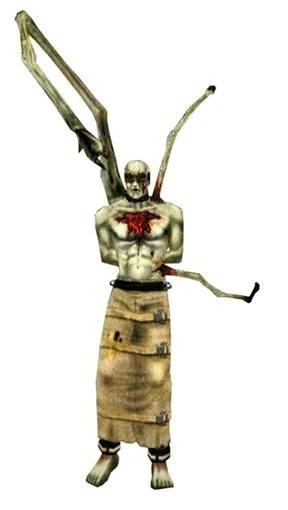

The last similarity isn’t related to the real animal but to an item. To activate the self-destruct system, you have to assemble a dragonfly key. On the underside of this key is a prominent red jewel in the middle of its thorax, similar to Alexander’s exposed heart.

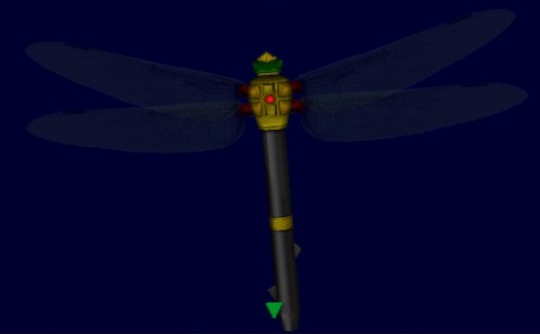
The dragonfly in the video is rather large. It has a blue abdomen with black markings and a yellow thorax. I tried to find out what dragonfly species we see there and found three possible candidates. One is the green hawker (Aeshna viridis), another is the southern migrant hawker (Aeshna affinis), and the last one is the emperor dragonfly (Anax imperator). (I’m not a dragonfly expert, though. Maybe there are other ones that fit better.)
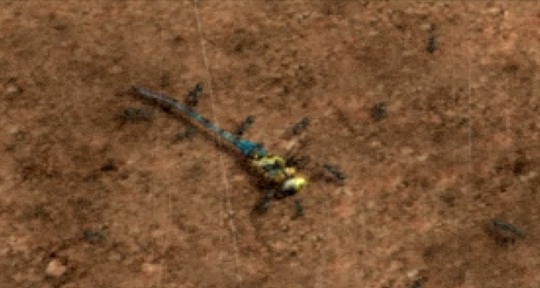
The abdomens of the green hawker and southern migrant hawker are also blue, the thorax is yellowish-green, and they have black markings on their bodies. The emperor dragonfly has an apple-green thorax rather than a yellow one, but it would fit the other criteria. Other dragonfly species with a similar color palette have either more black markings, differently colored spots on the abdomen, a different body shape, or are too small. In all three cases, only the males have this coloration. The females are green or yellowish green instead of blue. Selecting a male dragonfly specifically could be another reference to Alexander. As for the emperor dragonfly and the southern migrant hawker, contrary to the green hawker, they also inhabit Great Britain, which delivers another connection to Alexander. And while Alexander is, of course, only an earl, not an emperor, an emperor dragonfly could still refer in a wider sense to his peer status.
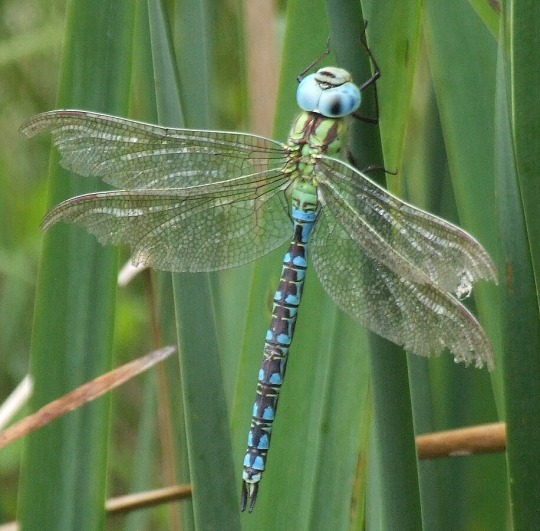
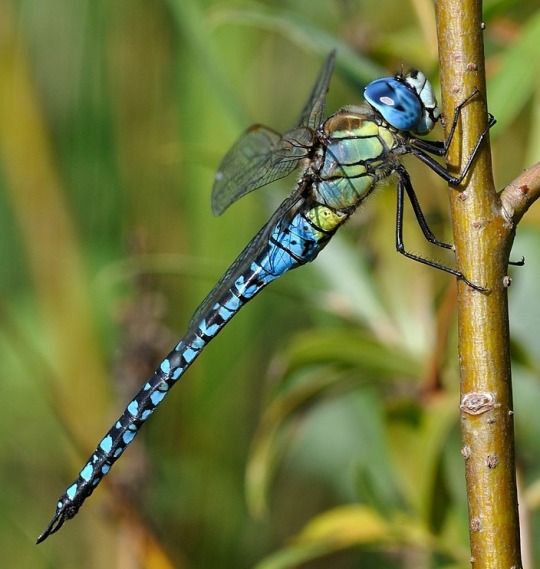

From left to right: green hawker (male), southern migrant hawker (male), emperor dragonfly (male).
The general events of the video reflect what happened to Alexander. Only Alfred interacts with the dragonfly. He was also the one who initiated the revenge plot after discovering the truth about himself and Alexia, as well as the one who suffered subjectively more under his father. Alexia stays passive the whole time and only watches her brother, while in real life, she is the one who has carried out the experiments, not Alfred. However, even if she does not join her brother here, Alexia still contributes by providing an instrument to execute the allegorical revenge - her ants (and the virus in reality).
Instead of simply killing the insect, Alfred rips out its wings, making it incapable of flying away. Like the dragonfly, Alexander was still alive when he met his fate. The twins tranquilized their father before Alexia injected him with the virus, which caused his transformation. Afterward, Alexander’s confinement continued, and he was chained for years in agony, probably awaiting his death if he was still capable of having coherent thoughts.
The dragonfly’s death is not in vain. Feeding the insect to the ants serves a purpose. The ants can feast on it, and the colony can grow. Alexander’s life wasn’t wasted either. Alexia directed Alfred’s revenge plans from simply killing their father to using him for research purposes. Their “useless father” could contribute for once to Alexia’s research and the Ashford family. Even though the experiment was a failure, Alexia was still able to use the data she required from it for her benefit.
Why all the effort with the cryptic symbolism? Alexander was a terrible father. Probably not intentional, but this isn’t an excuse. He took the childhood of the twins for the sake of his own ambitions. He used Alexia to fulfill what he could not achieve and disregarded Alfred for not being as intelligent as his sister. Finding out that they were the result of a genetic experiment was the final straw, especially for Alfred. Their father then got what he deserved, according to them. Alfred hated Alexander with a passion. It must have been a great feeling to get rid of him, and to celebrate it, he (maybe Alexia too) wanted a keepsake. Direct photos or videos of their father were out of the question. Alfred even wrote in his diary that they have to be careful so that Harman (their butler) doesn’t discover what has happened to Alexander. The dragonfly video works well. It is cryptic enough that no one could understand its meaning without more background knowledge. People who see it randomly would assume it is a disturbing and slightly eerie home video. Alfred and Alexia, on the other hand, know exactly what it is about. It’s so important to Alfred because it does not only show Alexia but also their victory over Alexander. The insects are nothing more than involuntary actors. The real dragonfly and what is happening to it is secondary. The symbolic meaning behind the dragonfly’s death struggle holds significance.
Some notes as a closure that didn’t fit in the rest of the text: What makes the video so creepy, except for the circumstances you find it in, is the twins’ acting. Without them and out of context, the dragonfly video wouldn’t even be that unsettling if you consider some facts. The video was recorded in the Antarctic base. Dragonflies do not inhabit Antarctica. This means the dragonfly was bred there. The twins did not randomly catch it for the purpose of torture. What’s the purpose of breeding dragonflies? I assume it’s for (virus) research. We know that Umbrella performed experiments on other invertebrates. So, if dragonflies are bred in the lab anyway, why not use some as a protein source for the ants as well? More common insects for feeding ants would be mealworms and meal beetles, house crickets, flies and fly larvae, roaches, and plant lice, though. Also, dragonflies are predators and attack everything they can overpower, including other dragonflies. And unlike ants, they can fly. It makes sense to remove the wings first to prevent it from flying away or attacking the ants. Sure, ripping out its wings and not killing it first is still cruel, but at least the ants will take care of this soon.
#resident evil#alfred ashford#alexia ashford#alexander ashford#ashford twins#🩸🌙#meta#re meta#uploading this video was the most bug-ridden thing i’ve ever encountered on tumblr#at least so far
24 notes
·
View notes
Text

Migrant Hawker, Aeshna mixta Canon 400D EF 100 2.8 f/ 11 1/320 iso: 800 Prague, Czech Republic 9/21/2009
#odonata#Dragonflies#Aesnidae#Aesna#hawkers#Insects#invertebrates#macro#ponds#wetlands#insectphotography#macrophotography#insect#canon
3 notes
·
View notes
Text











A look back on my 2024: Part 2 of 3-Mammals, dragonflies and damselflies, beetles and others
Another very strong mammalian year in which I saw my highest ever amount of species in a year centred on adorable Red Squirrels as I was lucky to observe them in Scotland and on Brownsea Island. Scotland was an incredible time with so many mammals observed; Stoat and Brown Hare adding to the magic of the wild cottage with lots of wildlife around to see that we stayed in and simply breathtaking wild experiences watching Bottlenose Dolphins on the Moray coast and a Mountain Hare in the Highlands. Roe Deer at the cottage and Red Deer during the week were other highlights with both species key to my year overall with amazing local Roe Deer views and the Bushy Park Red Deer and Fallow Deer experience which was great again in September. I had an amazing year for Stoats seeing two at Rutland Water in July as well and as my fortunes of seeing these species has taken an upturn the past year and a half we got fantastic Weasel views at Bempton Cliffs. We saw Field Voles really well there and got exceptional immersive views of Grey Seals at Flamborough Head. It was a splendid seal year with superb views of Common Seals on the Beaulieu River and in Newtown Harbour on the Isle of Wight on a boat trip in a strong run of mammals standing out in September. A Water Shrew was a surprise first for me as I waded through a flooded path at RSPB Radipole Lake in January and I was overjoyed to see a Water Vole at Rutland Water. Closer to home Fallow Deer and Sika Deer have been great to see in Hampshire and Dorset, with impressive home views of Hedgehogs and I had a magical year of observing beautiful Foxes with top sightings at Southsea and Hook-with-Warsash.
Perhaps unexpectedly again with similar to butterflies as mentioned in my last post a few species I really needed to work for this year I saw my highest ever amount of dragonflies and damselflies this year. It was a green dream for odonata in 2024 with a big moment seeing my first ever Downy Emerald dragonfly at Bentley Wood in May and both Emerald Damselfly and Willow Emerald Damselfly seen at Thurley and Fishlake Meadows respectively. Common, Ruddy and Black Darter gave me thrilling moments this year as did Black-tailed Skimmer with an especially good view of a female at Testwood Lakes and Keeled Skimmer. I was captivated by watching Golden-ringed Dragonflies at Winnall Moors, Testwood Lakes and Fen Bog Nature Reserve. Hawkers owned the summer with a strong couple of months or so seeing Migrant Hawkers and Southern Hawker and Brown Hawker enjoyed too. Azure, Blue-tailed and Large Red Damselflies were also very pleasant to see.
Beetles I suppose took another step up in importance for me this year as I kept a year list of ones I could identify for the first time ever recording twenty species. Green Immigrant Leaf Weevil, Violet Oil Beetle, Bloody-nosed Beetle, Tawny Longhorn beetle and Devil’s Coach Horse Beetle were some of my favourite finds. Once again cantharis rustic soldier beetle, Common Red Soldier beetle, Red-headed Cardinal beetle, Black-and-yellow Longhorn beetle, Swollen-thighed beetle and treasured views of epic Green Tiger Beetles at Bentley Wood in my home area, Strathdearn in Scotland and Fen Bog Nature Reserve in Yorkshire brough vibrant colour to my spring and summer. Dor beetles, ladybirds, Garden Chafer Beetle and Common Malachite Beetle were more delights seen this year.
Some other key species of my year included fascinating Hornet Mimic Hoverfly and Lesser Hornet Hoverfly in the summer, Marmalade Hoverfly, a notable amount of Common Lizards in the summer, frogs and frogspawn, the indomitable Long-winged Conehead one of my key crickets/grasshoppers of the year at Lakeside and Milford on Sea, Mottled shieldbugs, Dock bug, Forest bug, Grey Silverfish and spiders including Long-bodied Cellar spiders at home, lots of snails enjoyed at home and a fascinating Ambersnail seen at Winnall Moors in the summer.
The photos in this set are of; Keeled Skimmer dragonfly at Brownsea Island in September, Common Darter dragonfly at Lakeside in August, Willow Emerald Damselfly at Fishlake Meadows in October, Red Squirrel on Brownsea Island in September, Stoat at Rutland Water in July, Garden Chafer beetle at Magdalen Hill Down in May, Tawny Longhorn beetle on scabious at Shipton Bellinger in August, Hornet Mimic hoverfly at Stockbridge Down and Ambersnail at Winnall Moors in August, Fallow Deer in the New Forest on Good Friday and Long-winged Conehead at Lakeside in August.
#dragonflies#damselflies#beetles#mammals#red squirrel#common seal#grey seal#migrant hawker#downy emerald#bottlenose dolphin#dock bug#outdoors#macro#willow emerald damselfly#nature#walking#england#scotland#uk#world#moray#highlands#brown hare#mountain hare#stoat#europe#britain#wildlife#photography#wildlife photography
9 notes
·
View notes
Text
Description: Commedia dell'Arte characters
Zanni
The Zanni was a clown or buffoon, and this character drew from the lower classes of the time—the peasant or migrant who worked in Venetian society as a servant, or sometimes as an odd-job person or hawker. The Zanni mask used in the theatre was a full-face mask with a long nose, covering only the upper face.
Pantalone
The original name of this character was an old man named Magnifico, derived from San Pantalone, one of the saints venerated in the city of Venice; even the church is named after San Pantalone. The character, generally an old merchant, is often wealthy and esteemed, at other times completely ruined. The mask highlights his physical characteristics with a hooked nose and prominent eyebrows.
Il Dottore
Usually dressed in the traditional style of a medieval doctor, in a black suit, often with a ruff and a large doctor's cap, and a mask worn over half of his face that highlighted his bulbous nose. The doctor's name was only sometimes given; he was sometimes referred to as a learned physician and other times as a notary or lawyer.
Arlecchino (Harlequin)
cast as a bit of a dim-witted, silly, simple-minded person and perpetually hungry in the Zanni genre. Undertaking errands for his master or pursuing a pretty lady, or both, he pretends to be a soldier or a woman. His Harlequin costume usually includes a jacket and trousers with colourful and irregular patches, a white hat (often a rabbit or fox tail), and a belt with a wooden spatula. The mask has a pug nose and sometimes a bump on the forehead, usually with devilish and feline features.
0 notes
Text

There were lots of dragonflies about, including this male Migrant Hawker. This is the first time I have knowingly seen one in the UK - not that they are rare!
0 notes
Text
Seeking Culture and Identity in Local Essentialized (Mark this one, plz)

Singapore's essentialism emphasizes that it is a multicultural nation that encourages its citizens to respect and preserve local values and cultural traditions, while also supporting mutual respect and integration among all races. Singapore emphasizes people's identification with Singaporean culture and identity, but there is an essentialization problem in policy, language, race and culture.
The local essentialized of Singapore involves people's sense of identity and belonging to Singapore, which leads the country to become part of people's lives and shapes their behaviour and values. However, there might be some challenges in local essentialized. Due to made up of many different cultures and contexts in Singapore, it presents different cultural atmospheres and community characteristics that is difficult to form a common culture. In addition, a large number of migrant workers, new immigrants and local people here results in diverse races in Singapore. But some policy and institutional racialization persists. For example, preferential measures in racial policies, and racial classifications, may exacerbate divisions and identity issues between races. It also leads to a blurred sense of identity.
Although the local essentialized can strengthen the cohesiveness of people in Singapore, the lack of a common history and culture leads to blurred or split identity, and it is complicated to form a unified identity. Some racialized, hierarchical policies can also lead to disidentification with the state, leading to localism and exclusivity. This is harmful to developing multiculturalism which is contrary to promoting the concept of Singapore. Therefore, it is not desirable to blindly emphasize the local essence, but also respect and tolerate foreign culture and multiple races.
Reference list:
National Heritage Board. (n.d.). The History and Evolution of Hawker Culture of Singapore. Www.roots.gov.sg. https://www.roots.gov.sg/stories-landing/stories/Serving-Up-a-Legacy
0 notes
Text
"Shocking and Mysterious: Unsolved Murder Rocks Warangal's Railway Station Food Hub"
A 38-year-old individual running a food stall at the Warangal railway station was brutally murdered by a group of migrant hawkers at Shiva Nagar in Warangal during the early hours of Wednesday (August 30). According to the authorities, the victim, Nazeer, resided in Shiva Nagar and had a criminal record filed against him at the Mills Colony Police Station in Warangal. Nazeer was fatally attacked…
View On WordPress
0 notes
Text
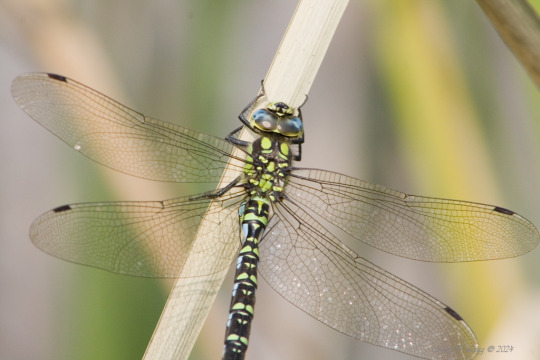
Migrant Hawker, Aeshna mixta Canon 400D EF 100 2.8 f/13 1/320 iso: 800 Prague, Czech Republic 9/21/2009
#odonata#Aeshnidae#Hawkers#dragonflies#damselfles#insects#invertebrates#macro#Wetlands#insectphotography#macrophotography#insect#canon
3 notes
·
View notes
